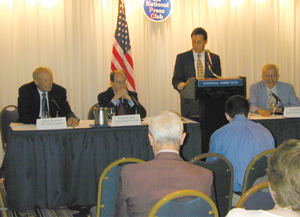
August/September 2003 (Volume 12, Number 8)
APS Study Questions Feasibility of Boost-Phase Missile Defense
 David Mosher of the BPI study group fields questions during the press conference releasing the report. Flanking him (l to r) are APS Past President William F. Brinkman and study co-chairs Frederick Lamb and Daniel Kleppner.  Lamb goes over details of the report with journalist Yoichi Nishimura of Asahi Shimbun. |
The APS study was co-chaired by Daniel Kleppner of MIT and Frederick Lamb of the University of Illinois, and conducted by a distinguished group of scientific experts. The last APS study, released in 1987, focused on the use of directed energy weapons for missile defense. "It is crucial that decisions about large-scale investments in weapons systems at least be based on scientific feasibility," said APS President Myriam Sarachik of the rationale for the APS study. "This is a much-needed study that fills a gap in our understanding of the problems of missile defense."
Among other findings, the study group determined that BPI has only limited applicability for defense against slower liquid-propelled ICBMs. However, BPI seems technically possible against short- or medium- range missiles launched from sea platforms off US coasts, provided that the interceptor missiles could be based within about 40 kilometers of an offensive missile's launch point. Other key issues examined in the study include munitions shortfall, missile tracking, determination of firing solutions, Airborne Laser requirements, maneuverability of interceptors, and geographic constraints on missile defense.
BPI strategies have received a great deal of media attention recently due to the relative ease of detecting a missile during boost phase (due to the bright plume) and the supposed difficulty in deploying counter- measures.
However, the report identifies effective countermeasures that have previously been used by missiles and shows that the key issue is one of timing.
According to Lamb, even assuming improvements in technology well beyond what is expected in the next 10-15 years, the basic problem is that the BPI strategy only gives two to three minutes for intercept. "Interceptors simply couldn't catch offensive ICBMs in time," he said. "The most optimistic scenarios still provide no time for human decisions and any system would need to be fully automated."
The APS study looked at BPI defense by ground-based interceptors, space-based interceptors and the Airborne Laser (ABL). Ground-based interceptors are primarily limited by the short window of opportunity for intercept and the requirement for basing interceptors close to the launch sites, generally within unfriendly foreign territory for missiles launched from North Korea or Iran.
Space-based interception would require a fleet of thousands of satellites in orbit just to intercept a single missile. Deploying such a fleet would exceed the US' space-launch capabilities by a factor of five to ten over the next decade. The ABL, currently in development, is limited by the range of the intense laser beam and its vulnerability to counterattack. Furthermore, the ABL would not be able to disable solid-propellant boosters in the time available for intercept.
North Korea and Iran could develop or acquire solid-propellant ICBMs within the next 10-15 years, according to US intelligences reports quoted in the study, and on that time scale, BPI defenses would be obsolete when finally deployed. "Few of the components that would be required for early deployment of a BPI defense currently exist," said Kleppner of the findings. "We see no means for deploying an effective BPI defense against ICBMs within ten years."
He cited other key issues that need to be further understood before a realistic deployment timeline can be determined, including communication, command and control networks and systems, and the process of an interceptor "hand-over" to the missile body after tracking the plume.
But there is one scenario where BPI defense seems feasible. "The existing US Navy Aegis system using a missile similar to the Standard Missile 2 should be capable of defending against short- or medium-range missiles launched from sea platforms off US coasts," the report concluded. "However, the interceptor missiles would have to be based within about 40 km of the launch point of the offensive missile."
The full report, downloadable in whole or in part is available on the APS web site, www.aps.org. It will be published as a supplement to a forthcoming issue of Reviews of Modern Physics.
©1995 - 2024, AMERICAN PHYSICAL SOCIETY
APS encourages the redistribution of the materials included in this newspaper provided that attribution to the source is noted and the materials are not truncated or changed.
Associate Editor: Jennifer Ouellette
August/September 2003 (Volume 12, Number 8)
Articles in this Issue
